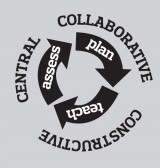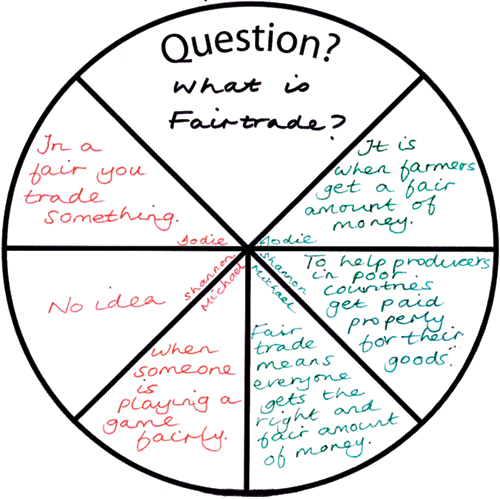Assessing a creative curriculum can be difficult, but Elaine Sutton has some practical and easy to use solutions...
Assessment. The very word causes some teachers to sigh deeply, whilst for others it conjures up happy visions of spreadsheets full of data, which they can analyse to their heart’s content. What teachers do tend to agree on, though, is why we need to assess pupils. We can’t help them to make progress without first working out how far down the road they’ve already come. But it’s the ‘how’ not the ‘why’ that is sometimes more tricky, particularly with all the pressures that come with the job.
 As this simple diagram below shows, assessment should be central, collaborative and constructive.
As this simple diagram below shows, assessment should be central, collaborative and constructive.
It should be central to the process of teaching and learning as an ongoing feature, both formally and informally. It should also involve collaboration - the term “assessment” originates from the Latin word “assidere” meaning “to sit beside”. This suggests a supportive and constructive partnership between participants. These three key elements should underpin the plan – teach – assess cycle.
Assessing a creative curriculum can be particularly challenging and establishing clear criteria against which to assess can be one of the main problems. Within a particular creative theme, it can be helpful to choose one or, at most, two subject areas to focus on. For example, if your theme was World War II then history might be the focus of your assessment. However, to maintain a good breadth of coverage, it’s important to ensure that different subject areas are chosen as the focus within the themes taught across each year group. Key subject skills and concepts should also be identified to establish clear assessment criteria.
Here are a few generic ideas that can help you to assess a creative curriculum. The ideas are both practical and easy to implement.
The Assessment Wheel is best used on a regular basis in order to ascertain children’s prior knowledge, skills and understanding within your theme. Key questions should be identified by the teacher and then used as a basis for assessment. The answers and responses should then help inform future planning. The process of using the Assessment Wheel is not to be confused with the KWL grids (What do I know about this topic? What do I want to know about it? What have I learnt about it?) as it is an ongoing, regular assessment focused on one particular aspect of the theme the teacher is planning to teach.
The choice of questions is vital in providing teachers with meaningful information. Changing the way a question is phrased can make a significant difference to the thought processes pupils need to go through, the language demands made on pupils and the extent to which pupils reveal their understanding. Open questions that have more than one correct answer often provide more opportunities for formative assessment, such as those beginning:
• Can you tell me one thing you know about…?
• How do you think you could…?
• Where would you find…?
• What if…?
For example, a Y2 teacher may have planned to teach about life cycles the following week and uses the Assessment Wheel to gauge pupils’ prior knowledge and understanding by asking the question “What is a life cycle?” If all the pupils have no real idea then the teacher may need to change her planning to reflect this, starting with simpler concepts than originally planned.
Pupils’ responses are recorded on the wheel and that same wheel is re-visited a week later, giving pupils the opportunity to reflect on responses given and add more information, based on what they have since learnt. A new, blank wheel is then completed using different questions as part of the ‘plan, teach, assess’ cycle.
The process of using the Assessment Wheel can be implemented in a variety of ways, with some teachers preferring to provide older pupils with their own individual wheels to complete, whilst others adopt a more collaborative approach, such as completing a wheel together; choosing perhaps three children in the class each week to give their answers. Choosing pupils with a range of abilities can really help the teacher to see the big picture of prior learning related to the class as a whole. In this instance, it is important to go back to the same children the following week for their responses in order to assess progress made
 The memory box is a special container where artefacts, which may have been used or made as part of the themed work, are stored. A collection of relevant items are made during the course of the theme and the box is added to regularly. Some of the artefacts can then be used to assess key skills and concepts. Relevant questions should be assigned to these items and pupils can be assessed on either an individual or group basis. This can take place orally and does not rely on written responses to indicate learning and subsequent progress. For example, if a KS1 class was studying the local area (geography assessment focus) then the memory box might contain some of the following artefacts linked with these questions:
The memory box is a special container where artefacts, which may have been used or made as part of the themed work, are stored. A collection of relevant items are made during the course of the theme and the box is added to regularly. Some of the artefacts can then be used to assess key skills and concepts. Relevant questions should be assigned to these items and pupils can be assessed on either an individual or group basis. This can take place orally and does not rely on written responses to indicate learning and subsequent progress. For example, if a KS1 class was studying the local area (geography assessment focus) then the memory box might contain some of the following artefacts linked with these questions:
• A Royal Mail sign - What other human features can we see in our local area?
• A twig collected on a walk - What other physical features can we see in our local area?
• A pupil’s map of the local area - Why do we use maps?
Responses can be recorded and then used to help inform future planning.
There are many advantages to setting a week aside for assessment purposes. Not only does it allow time for teachers to conduct any formal testing e.g. PIPs, practice SATs papers, reading tests etc. but it also provides an opportunity for assessment linked to the children’s current topic or theme to take place. The penultimate week of each half term is recommended, as this then leaves the last week as an opportunity to address any misconceptions or revise any difficult concepts, which may be highlighted as part of the assessment process.
Assessment should act as a signpost to guide teachers in their planning and teaching and, whichever approach you choose to take in assessing learning as part of the thematic approach, it should be manageable, focused and meaningful for everyone. Using tools such as the Assessment Wheel and memory box provides creative, practical ways to assess progress and celebrate learning.
Theme: Stewards of creation
Year group: 3 - 4
Date: 03/02/2012

Dimensions Curriculum Ltd provides schools with the services and resources to inspire excellent teaching and memorable learning. Elaine has a passion for promoting a love of learning and holds a deeprooted belief that education should explore how to ‘make the complicated simple’ through more creative and varied approaches. dimensionscurriculum.co.uk
Elaine Sutton is Creative Director and founder of Dimensions Curriculum Ltd. She has 16 years’ teaching experience across KS1 and KS2, has worked as an AST for music and was a local authority adviser before forming her company, dimensionscurriculum.co.uk
How Financial Education Helps Children
Ace-Classroom-Support
Make every lesson an experiment
Cross Curricular
